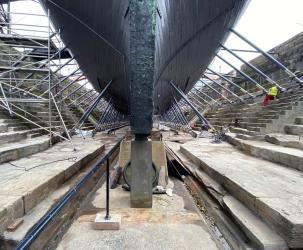
View from Astern, June 2020
When HMS Victory went into drydock in the Portsmouth Historic Dockyard in 1922, she was supported by 22 steel cradles. In the almost 100 years that she has remained on the dock, the historic ship’s 3,500-tonne hull had been to slowly collapse in on itself. To save the ship, the cradles have been replaced by an innovative system of 134 “props” that replicate the loads HMS Victory would have encountered while afloat. The ship will now be, at least figurately, floating in the drydock.
The new props, a collaboration between the National Museum of the Royal Navy and BAE Systems, are more than a series of struts to support the hull. Each prop contains sensors and hydraulics to monitor the load on the ship’s hull and adjust the weight being carried by each strut to most effectively support the 255-year-old wooden structure.
In addition to helping preserve the integrity of the ship’s hull, the new support system has another major benefit. The old steel cradles blocked the view of HMS Victory’s hull. Visitors will now be able to see the shape of the hull through the supporting struts.
“It’s an amazing, breath-taking space to be in,” said Matthew Sheldon, the museum’s head curator. “I’ve been here 26 years and I’ve never seen Victory like this before. The views of her bow and rudder are fabulous. You can get up close to the ship like never before.”
“It’s been a unique endeavour for a unique ship,” said Rob Hanway, Victory Programme Manager from BAE Systems which led the complex project.
“There’s never been anything quite like this before – a combination of the old and the new. Props have been used on cranes, but never on such a scale.
“Over the past 18 months, as we’ve taken out the old cradle, the sheer daylight flooding into the dock meant you noticed the difference and she looks pretty impressive. It’s been an absolute pleasure to work on her.”
The public can view Victory – and the rest of the sights in Portsmouth Historic Dockyard – when it re-opens on August 24. Numbers to the site will be limited to 250 per hour initially, and all visitors must book online in advance via: www.historicdockyard.co.uk/tickets-and-offers
Thanks to David Rye for contributing to this post.

The props look very similar — from what little is visible — to the the way larger sailing vessels used to be propped while under construction and/or repairs, maintenance such as painting. etc. with the stepped side walls for the space in which the vessel was located and long logs or pieces of wood extending from the side walls to the hull (horizontally). Hard to explain and the photos I can think of are usually naval vessels. I would guess that clipper ships might be similarly “arranged.”
I have always wondered why the British don’t leave vessels in the water, and haul them annually to service the bottom, check the caulking and fastening, do more anti fouling etc. That way a boat/ship would be supported by the water in such a fashion that she is on her lines and holding her shape.
Further to my comment above — such a “low tech” solution would, I bet, be significantly less expensive and certainly a lot simpler and easier to maintain.
I sincerely hope they make a better job of HMS Victory than was done to the Cutty Sark at Greenwich
I agree. The struts supporting the Cutty Sark are a horror show.
Wooden ships left afloat are all subject to serious problems with hogging. Both the USS Constitution and USS Constellation have had to undergo major restorations to correct significant hog. Unfortunately, there aren’t many easy answers to wooden ship preservation.
What an incredible engineering and curatorial achievement! I’ve watched the new system being installed and I’m very happy that is is a success. Victory is an international treasure — may she “float” for many centuries yet to come!
Hi Rick. The new props look great but the Royal Navy could probably have bought a frigate for the money spent!
I seem to recall you were less positive when Cutty Sark received similar treatment as part of her restoration. Maybe it was the “newness” of the look.
The support systems look very similar but are very different. The Cutty Sark is supported by 24 struts that have the ship literally hanging in the air by her tween deck. There is no support for the keel whatsoever. When the project Chief Engineer saw the plan as drawn up by the architects, he resigned convinced that it will damage the ship’s structure. Time will tell.
The Victory support system uses 134 struts as compared to 24 on the Cutty Sark. Victory is sitting on keel blocks. If too much of the ship’s weight is on the keel, the ship’s frames are unsupported and will begin to deform or sag. The 134 struts, or props, attempt to replicate the buoyancy of the water as if the ship was afloat, providing support for the frames, planking, and other structure. The system is adjustable so the engineers can control the loads on the hull to best suit the way the structure was designed originally.